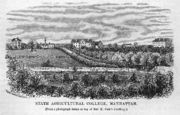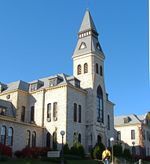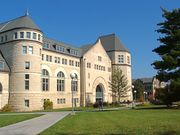Kansas State University
| Kansas State University | |
|---|---|
 |
|
| Motto | Rule by Obeying Nature's Laws |
| Established | 1863 |
| Type | Public, State, Land-grant, University |
| Endowment | $259.8 million[1] |
| President | Kirk H. Schulz |
| Academic staff | 1,305[2] |
| Students | 21,570 (Spring 2010)[3] |
| Undergraduates | 18,778[2] |
| Postgraduates | 4,366 |
| Location | Manhattan, Kansas, U.S. |
| Campus | College town; 668 acres (main campus) |
| Colors | Royal purple |
| Nickname | Wildcats |
| Affiliations | APLU, ASAIHL |
| Website | www.k-state.edu |
Kansas State University, which is commonly shortened to K-State, is an institution of higher learning located in Manhattan, Kansas, in the United States. The university has an official spring enrollment of 21,570 students for the 2009–2010 school year.[3]
A branch campus is located in Salina, Kansas, housing the College of Technology and Aviation. Another branch campus, known as the Olathe Innovation Campus, is presently under construction in Olathe, Kansas. When completed, the Olathe facility will be the academic research presence within the Kansas Bioscience Park, and will research bioenergy, animal health, plant science and food safety and security.[4]
The university is classified as a research university with very high research (RU/VH) by the Carnegie Classification of Institutions of Higher Education.
Contents |
History
Kansas State University, originally named Kansas State Agricultural College, was founded during the American Civil War on February 16, 1863, as a Land Grant institution under the Morrill Act.[5] The school was the first Land Grant college newly created under the Morrill Act, although several other universities claim to be the oldest Land Grant school.[5] K-State is the fourth-oldest school in the Big 12 Conference and the oldest public university in the state of Kansas.
The effort to establish the school began in 1861, when Kansas was admitted to the United States. One of the first things the new state Legislature needed to do was establish a state university. That year, the delegation from Manhattan introduced a bill to convert the old Blue Mont Central College (a private college incorporated in Manhattan in 1858) into the state university.[6] But the bill establishing the university in Manhattan was controversially vetoed by Governor Charles L. Robinson of Lawrence, and an attempt to override the veto in the Legislature failed by two votes.[7] In 1862, another bill to make Manhattan the site of the state university failed by one vote.[7] Finally, on the third attempt, on February 16, 1863, the state accepted Manhattan's offer to donate the Blue Mont College building and grounds, and established the state's Land Grant college at the site – the institution that would become Kansas State University.[7]
When the college opened for its first session in September 1863, it became only the third public institution of higher learning to admit women and men equally in the United States. The enrollment for the first session was 52 students: 26 men and 26 women.[5]
19th century

The early years of the institution witnessed debate over whether the college should provide a focused agricultural education or a full liberal arts education. During this era, the tenor of the school shifted with the tenure of the Presidents. For example, President John A. Anderson (1873–1879) favored a limited education and President George T. Fairchild (1879–1897) favored a classic liberal education.[5][8] Fairchild was credited with saying, "Our college exists not so much to make men farmers as to make farmers men."[5]
During this era, in 1873, Kansas State also helped pioneer the academic teaching of home economics for women, becoming one of the first two colleges to offer the program of study.[9][10]
Recent history
The name of the school was changed in 1931 to Kansas State College of Agriculture and Applied Science. In 1959, the name was changed again to Kansas State University of Agriculture and Applied Science to reflect a growing number of graduate programs.[11] From 1943 to 1950, Milton S. Eisenhower was President of the University, being succeeded by Dr. James McCain, who served from 1950 to 1975. Buildings, including residence halls and a student union, were added to the campus in the 1950s. The 1960s witnessed demonstrations against the Vietnam War, though fewer than at other college campuses. Enrollment was relatively high through most of the 1970s, but the university endured a downward spiral from approximately 1976 to 1986, when enrollment decreased to 17,570 and a number of faculty resigned. In 1986, Dr. Jon Wefald assumed the presidency of Kansas State University. During his tenure, enrollment and donations increased.

On June 15, 2009, Kirk Schulz became the thirteenth president of Kansas State University.[12] In March 2010 he announced his K-State 2025 plan.[13] The initiative is designed to elevate K-State to a top 50 nationally recognized research university by 2025.
Historic buildings
The university moved from the location of Blue Mont Central College to its present site in 1875.[5] The original site is now occupied by Central National Bank and Founders Hill Apartments. The first new building erected after the move was Holtz Hall, in 1876.[5] It is now the oldest free-standing building on campus. The signature building at Kansas State University, Anderson Hall, was erected in three stages between 1877 and 1884. The building, now listed on the National Register of Historic Places, has housed the University's administrative offices for more than a century.
Academic profile

Since 1986, Kansas State ranks first nationally among state universities in its total of Rhodes, Marshall, Truman, Goldwater, and Udall scholars with 124 recipients.[14]
Kansas State University has 60 academic departments in nine colleges: Agriculture; Architecture, Planning, and Design; Arts and Sciences; Business Administration; Education; Engineering; Human Ecology; Technology and Aviation; and Veterinary Medicine. The graduate school offers nearly 100 master's degree programs and nearly 50 doctoral programs.
In 1991, the former Kansas Technical Institute in Salina, Kansas was merged with Kansas State University by an act of the Kansas legislature. The College of Technology and Aviation is located at the Salina campus, and is commonly referred to as K-State Salina.
K-State is also known for several distinguished lecture series: Landon Lecture, Lou Douglas Lecture, Huck Boyd Lecture, and Dorothy L. Thompson Civil Rights Lectures.
K-State implemented an academic honor code in 1999.[15] When students are admitted, it is implied that they will adhere to the Honor Pledge: "On my honor, as a student, I have neither given nor received unauthorized aid on this academic work."
Research and cultural resources

Agriculture
The university has had a long-standing interest in agriculture, particularly native Great Plains plant and animal life. The Kansas State University Gardens is an on-campus horticulture display garden that serves as an educational resource and learning laboratory for K-State students and the public. The Konza Prairie is a native tallgrass prairie preserve located south of Manhattan, which is co-owned by The Nature Conservancy and Kansas State University and operated as a field research station by the Department of Biology. The university also owns an additional 18,000 acres (73 km2) across the state that it operates as Agricultural Experiment Stations in research centers in Hays, Garden City, Colby, and Parsons.
Arts and culture
The university is home to several museums, including the Marianna Kistler Beach Museum of Art, the KSU Historic Costume and Textiles Museum, and the Chang, Chapman, and Kemper Galleries which feature faculty and student artwork. The university also offers an annual cycle of performance art, including concerts, plays and dance, at McCain Auditorium.[16]

The Biosciences
In 2006, K-State dedicated the Biosecurity Research Institute. [17] The BRI, which is in Pat Roberts Hall, is a safe and secure location in which scientists and their collaborators can study high-consequence pathogens. It was designed and constructed for biosafety level 3 (BSL-3) and biosafety level 3 agriculture (BSL-3Ag) research. [18]
The availability of the BRI was part of what attracted the National Bio and Agro-Defense Facility to K-State and Manhattan. [19] The NBAF will consist of approximately 500,000 square feet of research and support space. [20] The construction of the NBAF is estimated to cost $650 million and should be complete by 2016. [21] It will be built just north of K-State's College of Veterinary Medicine and east of the BRI. [22]
Following the NBAF decision, the leaders at two additional federal facilities announced that they are coming to K-State. The Arthropod-Borne Animal Disease Research Unit — or ABADRU — specializes in animal and plant diseases transmitted by insects. The lab is relocating from Laramie, Wyo., to K-State so it can fully realize its research mandate. [23] The Center of Excellence for Emerging and Zoonotic Animal Diseases — or CEEZAD — will research foreign animal, zoonotic and newly discovered pathogens that can have a consequential economic impact on U.S. agriculture, homeland security and human and animal health. It will be led by K-State's Dr. Juergen Richt. [24]
Landon Lecture Series
The Landon Lecture Series is offered by Kansas State University for students, faculty and the community. The Landon Lecture Series is named in honor of former Kansas governor and presidential candidate, Alfred Landon.
Prominent leaders and former leaders, primarily political or heads of government, have given speeches in the series. For example, on January 23, 2006, U.S. President George W. Bush delivered the University's 143rd Landon Lecture at Bramlage Coliseum. On March 2, 2007, his predecessor, Bill Clinton, delivered the 149th Landon Lecture.[25] Also, on September 23, 2008, former Mexican president Vicente Fox gave the 152nd Landon Lecture on that afternoon.[25] Overall, six U.S. Presidents and three foreign presidents have given Landon Lectures at K-State.[26] There are approximately four speakers per year.
Physics
Among the university's research facilities are the James R. Macdonald Laboratory for research in atomic, molecular and optical physics and the NASA Center for Gravitational Studies in Cellular and Developmental Biology. The excimer laser, which made LASIK eye surgery possible, is a technology developed by Kansas State researchers.[27]
Other research facilities include:
- Institute for Environmental Research
- The National Gas Machinery Laboratory
- TRIGA Mark II Nuclear Research Facility
- Semiconductor Materials and Radiological Technologies (S.M.A.R.T.) Laboratory
- Center for Complex Fluid Flows
Intercollegiate athletics

Kansas State's sports teams are called the Wildcats. They participate in the NCAA's Division I and the Big 12 Conference. The official color of the teams is Royal Purple, making Kansas State one of very few schools (including also Syracuse and Harvard) that have only one official color; white and silver are commonly used as complementary colors.[28]
Sports sponsored by the school include football, basketball, cross country and track, baseball, golf, tennis, rowing, equestrian and volleyball. The head football coach is Bill Snyder, the head men's basketball coach is Frank Martin, the head women's basketball coach is Deb Patterson and the head baseball coach is Brad Hill.
Notable alumni
Beginning with the first graduating class in 1867[29], a number of Kansas State alumns have gone on to distinguished careers. Presently, both U.S. Senators from Kansas are graduates of Kansas State University. Other graduates currently serve as the Vice-President of Liberia, the president of the Georgia Institute of Technology, and the interim executive director of the NCAA. Kansas State alums have been enshrined in the Rock and Roll Hall of Fame and the College Football Hall of Fame, and have earned Emmy Awards and Olympic gold medals.

Campus
The main campus of Kansas State University in Manhattan covers 668 acres (2.70 km2). Since 1986, Kansas State has added over 2 million square feet (186,000 m²) of buildings to the campus, including a new library, art museum and plant sciences building.
Several of the buildings on the campus were heavily damaged by an EF4 tornado on June 11, 2008. Total damage estimates were at $20 million plus.[30] K-State paid for their insurance to repair all damages through a $5 million deductible.
Main campus buildings
|
|
|
Student life

Residential life
K-State has 10 residence halls on campus: Boyd Hall, Ford Hall, Goodnow Hall, Haymaker Hall, Marlatt Hall, Moore Hall, West Hall, Putnam Hall, Van Zile Hall, and Smurthwaite as well as the Jardine Apartments. Ford and Boyd Halls are all female. Marlatt Hall was an all-male residence hall until Fall 2009 when it became co-educational [31]. The residence halls are divided into three complexes: Derby, Kramer, and Strong.[32]
Student organizations
Kansas State has more than 400 student organizations.[33]
The Student Governing Association is the largest organization of student leaders composed of elected and appointed officials. The Student Governing Association is modeled after the U.S. government, with executive, legislative, and judicial branches.
GSA is the Graduate Student Association, members include KSU Master of Business students.
Kansas State University also offers Army ROTC (Reserve Officers' Training Corps) and Air Force ROTC programs.
Student media
- Radio Station: KSDB-FM The Wildcat 91.9 Student Radio
- Newspaper: Kansas State Collegian
- Yearbook: Royal Purple Yearbook
- Television: Purple Power Hour & Manhattan Matters
References
- ↑ "2009 NACUBO Endowment Study" (PDF). NACUBO. http://www.nacubo.org/Documents/research/2009_NCSE_Public_Tables_Endowment_Market_Values.pdf. Retrieved 2010-03-03.
- ↑ 2.0 2.1 "Kansas State University Fact Book 2009" (English). http://www.k-state.edu/pa/statinfo/factbook/student/totdemo.pdf. Retrieved 2010-03-09.
- ↑ 3.0 3.1 "Enrollment numbers--1990-current" (English). http://www.k-state.edu/media/mediaguide/enrollment.html. Retrieved 2010-03-09.
- ↑ "K-State Olathe Innovation Campus, Inc." (English). http://kstateoic.ksu.edu/. Retrieved 2009-04-30.
- ↑ 5.0 5.1 5.2 5.3 5.4 5.5 5.6 Willard, Julius (1940). History of Kansas State College of Agriculture and Applied Science. Kansas State College Press. http://hearth.library.cornell.edu/cgi/t/text/pageviewer-idx?c=hearth;cc=hearth;rgn=full%20text;idno=5725255;didno=5725255;view=image;seq=0003;node=5725255%3A3.
- ↑ Willard, Julius (May 1945). "Bluemont Central College, the Forerunner of Kansas State College". Kansas Historical Quarterly. http://www.kshs.org/publicat/khq/1945/45_6_willard.htm. Retrieved 2008-01-29.
- ↑ 7.0 7.1 7.2 Griffin, C.S.. "The University of Kansas and the Years of Frustration, 1854–64". http://www.kshs.org/publicat/khq/1966/66_1_griffin.htm. Retrieved 2006-10-06.
- ↑ Kansas: A Cyclopedia of State History. Standard Publishing Co.. 1912. http://skyways.lib.ks.us/genweb/archives/1912/a/agricultural_college.html. Retrieved 2009-01-13.
- ↑ Craig, Hazel; Stover, Blanche (1946). The History of Home Economics. pp. 5. ISBN 0585061998. http://hearth.library.cornell.edu/cgi/t/text/pageviewer-idx?c=hearth;cc=hearth;rgn=full%20text;idno=5725268;didno=5725268;view=image;seq=7;node=5725268%3A5;page=root;size=s;frm=frameset;. Retrieved 2009-09-01.
- ↑ "History of the K-State College of Human Ecology". http://www.humec.k-state.edu/about/history-college.php. Retrieved 2009-09-01.
- ↑ "University Archives Facts and Flyers". http://www.lib.k-state.edu/depts/spec/flyers/. Retrieved 2008-03-05.
- ↑ Kansas State Collegian Schulz begins new term
- ↑ K-State News Services "K-State beginning ambitious plan for next 15 years to be a top 50 public university"
- ↑ "Top Scholar Rankings 1986–2008" (English). http://www.k-state.edu/media/achievements/scholarstop10of5pub.pdf. Retrieved 2008-05-12.
- ↑ "KSU Honor Code". http://www.k-state.edu/honor. Retrieved 2007-03-02.
- ↑ "McCain Auditorium website". http://www.k-state.edu/mccain/. Retrieved 2007-09-20.
- ↑ K-State News Services "K-State's Biosecurity Research Institute to provide research, training space for food safety and security efforts"
- ↑ "Biosecurity Research Institute website" (English). http://www.bri.k-state.edu/Aboutus/tabid/71/Default.aspx/. Retrieved 2010-07-26.
- ↑ 49 News KTKA "NBAF officials say they plan to do research at the BRI"
- ↑ "National Bio and Agro-Defense Facility website" (English). http://www.dhs.gov/files/labs/gc_1181072257904.shtm/. Retrieved 2010-07-26.
- ↑ "NBAF in Kansas website" (English). http://www.nbafinkansas.org/FAQ.aspx#q1/. Retrieved 2010-07-26.
- ↑ "National Bio and Agro-Defense Facility website" (English). http://www.dhs.gov/files/labs/gc_1188509623607.shtm/. Retrieved 2010-07-26.
- ↑ K-State Collegian "City officials announce relocation of federal lab"
- ↑ "About CEEZAD College of Veterinary Medicine website" (English). http://www.vet.k-state.edu/CE/2010/ei_overview.htm/. Retrieved 2010-07-26.
- ↑ 25.0 25.1 "Landon Lecture Series – Past Speakers". http://ome.ksu.edu/lectures/landon/past.html. Retrieved 2008-10-16.
- ↑ "Landon Lecture Series – New Speakers". http://ome.ksu.edu/lectures/landon/new.html. Retrieved 2007-03-02.
- ↑ "Kansas State University Achievements" (English). http://www.mediarelations.k-state.edu/WEB/News/NewsReleases/priorasaccomplishments.html. Retrieved 2006-09-25.
- ↑ "Kansas State Traditions" (English). http://www.kstatesports.com/ViewArticle.dbml?DB_OEM_ID=400&KEY=&ATCLID=37671. Retrieved 2008-11-30.
- ↑ Record of the Alumni of the Kansas State Agricultural College. 1914. http://skyways.lib.ks.us/genweb/education/ksu/ksugrads1.html.
- ↑ Wichita Eagle-Beacon Tornadoes rip Manhattan, KSU damage more than $20 million
- ↑ http://housing.k-state.edu/rsvp/faq.php#a5
- ↑ K-State Housing and Dining Services
- ↑ Student organizations
- Carey, James C. (1977). Kansas State University: The Quest for Identity. Lawrence, Kansas: The Regents Press of Kansas. ISBN 0700601562.
External links
|
|||||||||||||||||||||||
|
|||||||||||||||||
|
||||||||